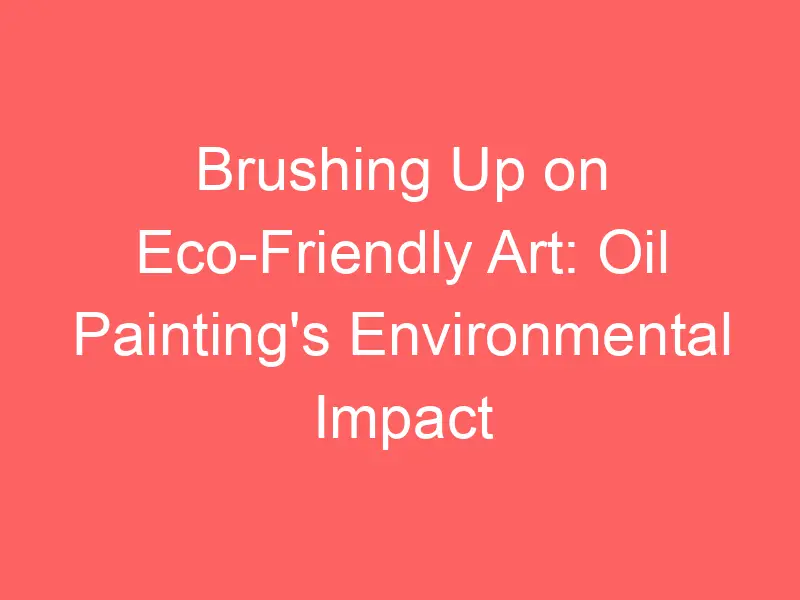Choosing the right canvas for oil painting is an important part of creating a quality piece of artwork.
It can make the difference between success and failure, so it’s important to take your time when selecting the proper canvas for your painting project.
Here are some tips to help you choose the best canvas for your oil paintings:
1. Consider Size: When choosing a canvas, consider both the size and orientation of your painting.
If you’re planning on creating a larger piece, pick a large-sized canvas that will allow you to put more detail into each stroke.
On the other hand, if you’re planning a small-scale painting, opt for a smaller canvas to ensure accuracy in your brushwork.
2. Think About Texture: The texture of the canvas you select will have a big impact on how your painting looks.
Look for canvases with a medium to rough texture that will enable your brushstrokes to stand out and create an aesthetically pleasing effect.
3. Choose Quality Materials: Poor quality materials can ruin your painting, so make sure you choose a high-quality canvas made from 100% cotton or linen fabrics that are acid-free and pre-stretched.
4. Know Your Needs: If you plan on creating commissioned pieces for clients, then it’s important to know what type of canvas they prefer before purchasing it.
If you’re just starting in oil painting, then opt for a lower-priced option until you get a feel for the medium.
By keeping these tips in mind, you’ll be able to choose the best canvas for your oil paintings and ensure a high-quality piece of artwork. Have fun exploring all the different textures and sizes available!
What Type of Canvas Should I Use for Oil Painting?
When you are painting, the type of canvas that you use is important. You need to choose a surface that will allow your paint to dry and not leak through.
It should also be durable so that it doesn’t get damaged easily. There are many materials for painting, but canvas is one of the most popular choices for artists.
This is because the canvas is a more affordable option than other surfaces and allows artists to paint on it in any size they want.
The best type of canvas for oil paintings would be cotton or linen canvas.
These are both durable, absorbent, and easy to clean up after painting on them.
They can also be stretched without losing their shape very easily, which makes them perfect options for artists who want to create large pieces or multiple smaller ones at once.
If you want something with more texture or durability, then polyester may be a good option for you since it won’t absorb water as quickly as cotton or linen canvases will when wet.
If you want something cheaper and easier to clean up after painting on it, then acrylic might be a good choice for you because it is lighter in weight than other canvases and does not require as much care from the artist during the drying process after painting on them.
| Canvas Type | Description | Pros | Cons |
|---|---|---|---|
| Cotton Duck Canvas | A popular choice for oil painting, made of woven cotton fabric. | Durable, affordable, and comes in a variety of weights and textures. | May sag or stretch over time, and may require additional priming. |
| Linen Canvas | A high-quality canvas made from woven linen fibers. | Durable, has a smooth surface, and resists deterioration over time. | More expensive than cotton, and may be more difficult to find in stores. |
| Polyester Canvas | A synthetic canvas made of polyester fibers. | Durable and resistant to moisture, mildew, and UV damage. | May have a less natural texture and appearance, and may require additional priming. |
| Wooden Panels | Canvas stretched over a wooden frame or panel. | Durable, rigid, and won’t sag over time. | More expensive than traditional canvas, and may be heavier and harder to transport. |
Can You Use Oil Paint on a Normal Canvas?
Yes, you can use oil paint on a normal canvas. Oil paints have been used to create some of the most iconic pieces of artwork in history and are still widely used by professional artists today.
Since they are made from natural ingredients, they dry slowly and give artists plenty of time to work with the colors before they set.
The most important thing to consider when painting with oils is that you need a thick enough canvas to support the weight of the paint as it dries.
Normal canvases should be at least 8 ounces per square foot or thicker for optimal results.
It’s also important to prime your canvas with an appropriate primer before applying oil paints so that it does not absorb too much of the color from the paint.
Finally, you should wait for your painting to fully dry before varnishing it with a protective coating. This will help to preserve the color and texture of your painting over time.
What Is the Most Popular Canvas Size?

The most popular canvas size for oil painting is usually between 18”x24” and 24”x36”.
This size range allows you to comfortably work on a larger scale while still having the ability to make detailed brushstrokes.
However, if you are looking for something bigger, then there are canvases in sizes up to 60” x 84” available on the market.
These large sizes are great for creating bold, sweeping paintings that can be seen from a distance.
Whichever size you choose will depend on your personal preferences and the subject matter of the piece that you plan on creating.
No matter which size canvas you choose, it is important to use quality materials that are acid-free and rated for archival use so that your work will last a long time.
This is especially important if you plan on selling or exhibiting your artwork.
No matter what type of canvas you decide to use for painting with oils essential important to practice and experiment with the medium before tackling more complex pieces.
This way, you can develop the skills needed to create beautiful works of art that will last for many years.
What Weight Canvas Is Best for Oil Painting?
The best-weight canvas for oil painting is usually 8 ounces per square foot or thicker.
This will provide enough support for the painting as it dries, and you won’t have to worry about any sagging or warping of the canvas over time.
Thicker canvases are also better suited for larger paintings and those that require detailed brushstrokes.
However, if you want something lighter in weight so it’s easier to move around or transport, then a thinner canvas may be a better option for you.
No matter what weight canvas you choose, make sure that it is rated for archival use so that your artwork lasts longer without fading or cracking.
Is a Thick or Thin Canvas Better?
The answer to this question depends on the type of artwork you plan on creating.
Thicker canvases are generally better for larger pieces and those that require more detail, as they will provide enough support for the paint as it dries.
On the other hand, if you want something lighter in weight or easier to transport, then a thinner canvas may be a better option for you.
Whatever type of canvas you decide on, make sure that it is acid-free and rated for archival use so that your artwork lasts longer without fading or cracking over time.
It’s also important to prime your canvas with an appropriate primer before painting with oil paints so that it does not absorb too much of the color from the paint.
This will help to ensure that you get the best results for your artwork.
Now that you know more about oil painting and choosing the right canvas, it’s time to get creative and start creating some beautiful works of art!
Which canvas board is best for oil painting?

When it comes to oil painting, the best type of canvas board to use is one that is specifically designed for use with oil paints. Canvas boards are made from tightly woven cotton or linen fabric that has been glued or stapled onto a solid base such as wood or cardboard.
This provides strong and durable support for the paint. For oil painting, look for boards that are unbleached and untreated so that the paint can better penetrate the fibers of the canvas. For those looking to explore more expensive options, Belgian linen canvas boards may be a great choice.
Belgian linen is considered to be one of the finest quality canvases due to its high-density weave and its ability to maintain tension while being stretched over a wooden frame. This makes it ideal for achieving fine details in your artwork as well as providing superior durability and longevity when compared with other types of canvas board material.
What is the difference between stretched and unstretched canvas for oil painting?
Stretched canvas for oil painting is when the canvas has been stretched over a wooden frame, allowing it to be taut and ready for immediate use. This makes it much easier for the artist to lay down paint as the canvas won’t move around or distort when being worked on.
Unstretched canvas, on the other hand, needs to be attached to a wooden frame before it can be used. It also needs to be primed so that the fabric won’t absorb too much of the oil paint causing it to crack or flake off over time. Unstretched canvas is often preferred by painters who want more control over how much tension they apply while stretching their artwork.
How do I know if a canvas is properly primed for oil painting?
To determine if a canvas is properly primed for oil painting, it’s important to look for a smooth and even layer of primer on the surface. Typically, gesso or acrylic underpainting will be used as a primer for oil paints, although some artists may opt for an oil-based primer instead.
To test the quality of the priming layer, try running your finger over it. If you can feel any bumps or ridges in the surface then this indicates that the canvas was not properly primed and may cause problems later down the line. You can also visually inspect the canvas from different angles to see if there are any inconsistencies or patches where paint hasn’t been applied evenly.
Applying two coats of primer is often recommended when working with oil paints as this allows for greater flexibility and opacity when layering colors. When applying primer, take your time to make sure each layer is brushed on smoothly and evenly with no streaks or brush marks showing in order to ensure a professional finish in your artwork.
What is the best way to store unused canvases for oil painting?
When storing unused canvases for oil painting, it is important to make sure they are stored in a cool, dry place away from direct sunlight. Canvases should also be wrapped securely in acid-free paper or plastic to protect them from dust and other contaminants that can damage the canvas over time.
Additionally, the wrapping should be tight enough so that air and moisture don’t become trapped inside as this can lead to mold and mildew growth which can ruin a canvas. For more long-term storage needs, consider using archival storage boxes which are designed specifically for preserving artwork and provide superior protection against fading caused by UV rays or humidity.
Archival storage boxes are made from materials such as polyethylene or polypropylene which help to trap air inside while keeping out dust, dirt, and other contaminants that can cause damage to your artwork over time.
Can I use a canvas that has already been painted on for oil painting?
Yes, it is possible to use a canvas that has already been painted for oil painting. However, depending on the paint used previously and the primer or sealant applied, proper preparation may be required before going ahead with the painting.
The existing paint must first be removed in order to create an even surface for the new painting. If the existing paint was an oil-based medium such as acrylic or oil, then this can be done by scraping off any loose particles and then sanding it down. Alternatively, a chemical stripper may be necessary if the existing paint is particularly stubborn.
The next step is to apply a sealant or primer over the surface of the canvas in order to provide a suitable base for painting with oils. Many artists opt for gesso since this provides excellent adhesion and prevents oil from being absorbed too deeply into the fibers of the canvas as well as providing additional protection against cracking.
Once all of these steps have been completed and any extra dust has been removed from the canvas surface, it should be ready to use for oil painting!

Conclusion
Choosing the right canvas for oil painting can be a daunting task, but with the information provided in this article, it doesn’t have to be. When selecting your canvas board, look for one made from tightly woven cotton or linen fabric and opt for an unbleached and untreated version so that the paint can better penetrate its fibers.
For those looking to explore more expensive options, Belgian linen is considered to be one of the finest quality canvases due to its high-density weave and ability to maintain tension while being stretched over a wooden frame. Additionally, you should consider whether you want a pre-stretched or unstretched canvas as each offers different benefits depending on what type of control you need over your artwork.
Finally, always make sure to properly prepare any previously used canvases by removing existing paint layers before applying primer or sealant in order for them to become ready for use again. With these tips in mind, we hope that finding just the right canvas will now seem much less intimidating!


















